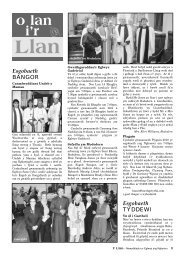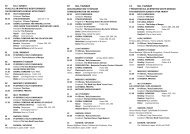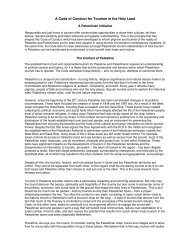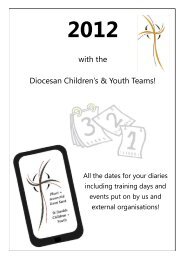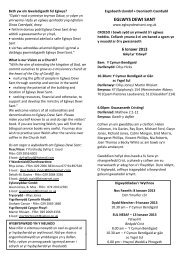Alternative Funeral Service - Yr Eglwys yng Nghymru
Alternative Funeral Service - Yr Eglwys yng Nghymru
Alternative Funeral Service - Yr Eglwys yng Nghymru
You also want an ePaper? Increase the reach of your titles
YUMPU automatically turns print PDFs into web optimized ePapers that Google loves.
I. NOTES TO THE FUNERAL SERVICE<br />
1. SENTENCES<br />
Sentences of Scripture may be used at the entry, after the Introduction,<br />
or at other suitable points.<br />
2. RECEIVING THE COFFIN<br />
The coffin may be received into the church at the beginning of the service, or earlier in the day,<br />
or on the day before the funeral. The Paschal Candle may stand beside the coffin and may<br />
be carried in front of the coffin when it is brought into the church. Where it is the practice, the<br />
coffin may be sprinkled with water on entry. This may also occur at the Commendation or at<br />
the Committal. A pall may be placed over the coffin in church by family, friends or other members<br />
of the congregation. Appropriate symbols of the life and faith of the departed person<br />
may be placed on or near the coffin before or at the start of the service or after the opening<br />
prayer and hymn. Silence is kept. At the sprinkling, the placing of the pall or symbols, the<br />
words in Section VII below may be used.<br />
3. HYMNS, PSALMS AND READINGS<br />
Points are suggested at which hymns may be sung, but they may be used at any suitable<br />
place. A selection of hymns and anthems is provided in Section XIV below. Psalms and Readings<br />
should normally be drawn from those set out in Part 1, or in Section XII below. A psalm<br />
should normally be used. It may be in a metrical or hymn version, or be replaced by a scriptural<br />
song. For Canticles see Section XIII below. There must always be one reading from the<br />
Bible. Appropriate non- biblical texts may be read before the Tribute.<br />
4. SERMON AND TRIBUTE<br />
The primary purpose of a Sermon, which should always be given by an authorised minister,<br />
is to proclaim the gospel in the context of the death of the deceased. A tribute, remembering<br />
and honouring the life of the person who has died, and the evidence of God’s grace and work<br />
in them, may be made and/or an appropriate non-biblical text may be read at some suitable<br />
point at the discretion of the minister.<br />
5. CREED<br />
An authorized Creed or an authorized Affirmation of Faith may be said after<br />
the Sermon.<br />
<strong>Funeral</strong> <strong>Service</strong>s<br />
6. THE COMMITTAL<br />
The Committal is used at the point at which it is needed, for example:<br />
(a) at the burial of the body in a cemetery or churchyard;<br />
(b) at the interment of cremated remains when this follows on the same day or the day<br />
following cremation, in which case the prayer “if the Committal is to follow at the Burial of<br />
the Cremated Remains” is used at the crematorium;<br />
(c) at a crematorium when the interment of cremated remains is not to follow immediately ;<br />
(d) at the interment of cremated remains when cremation has taken place without any formal<br />
service ;<br />
(e) when burial takes place at sea;<br />
(f) when the body or the cremated remains are to be deposited in a vault, mausoleum or brick<br />
grave, when these words may be used at the Committal: “We have entrusted our<br />
brother/sister to God’s mercy, and we now commit his/her body to its resting place.”<br />
Forms of Commendation and Committal are provided, but when occasion demands other<br />
authorised forms may be used.<br />
Page 25



